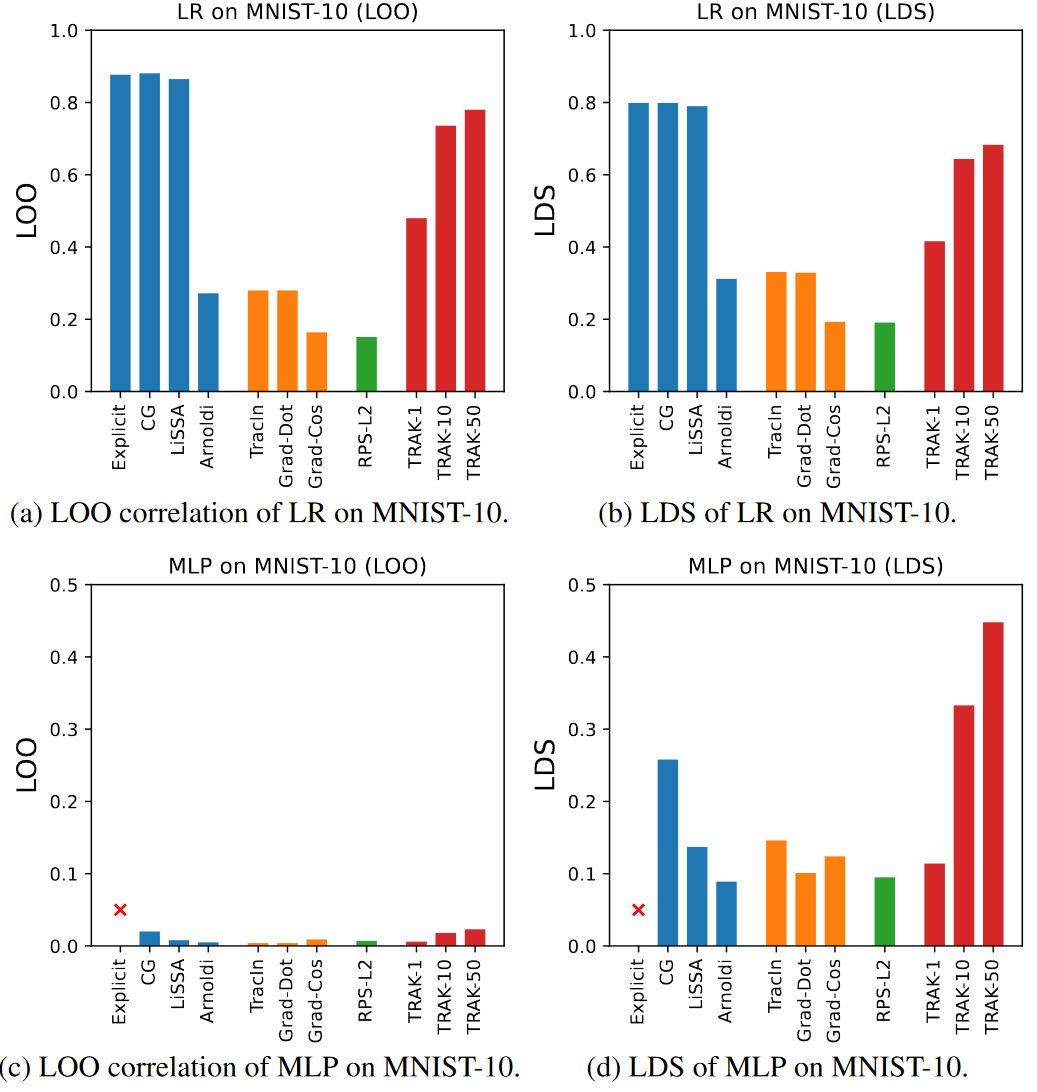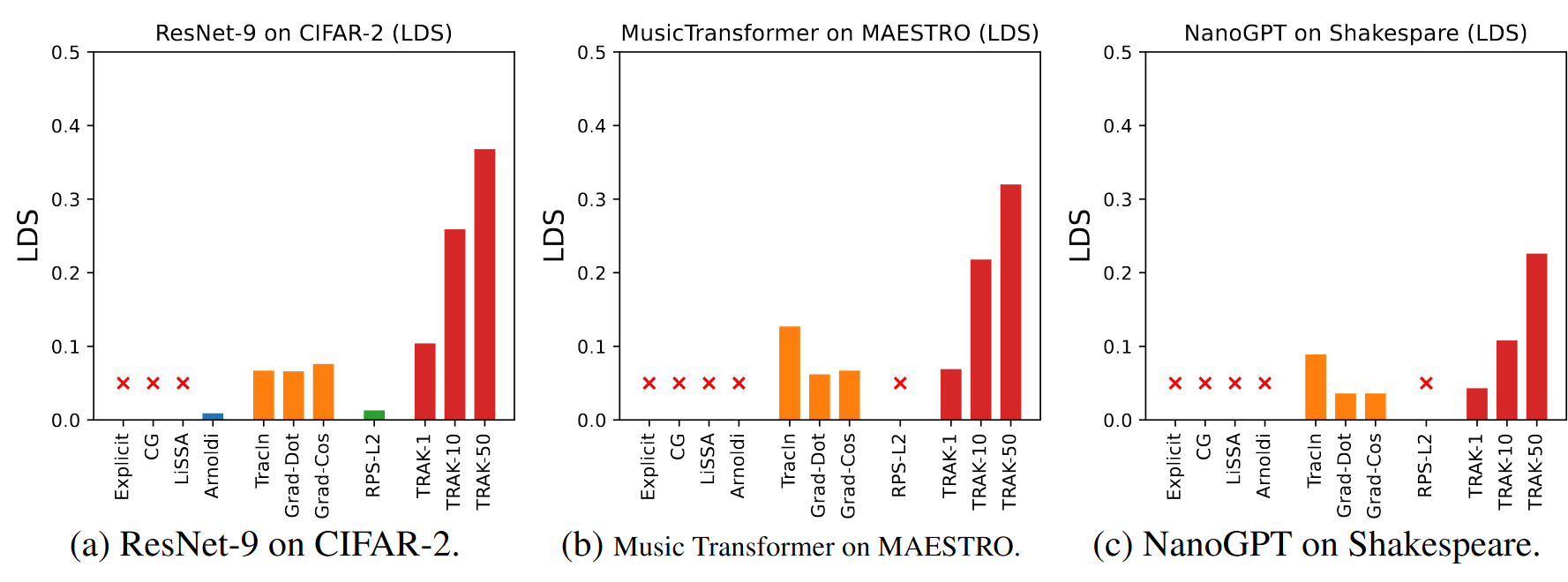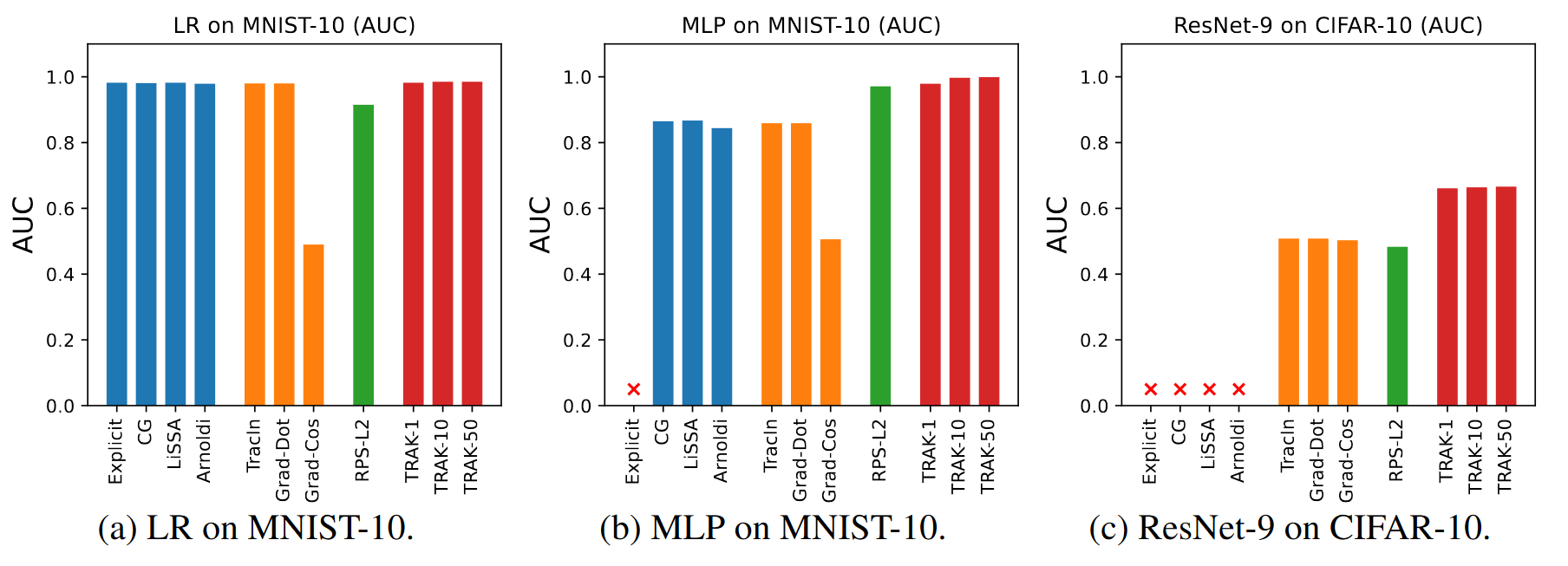dattri is a PyTorch library for developing, benchmarking, and deploying efficient data attribution algorithms. You may use dattri to
- Deploy existing data attribution methods to PyTorch models
- e.g., Influence Function, TracIn, RPS, TRAK, ...
- Develop new data attribution methods with efficient implementation of low-level utility functions
- e.g., HVP/IHVP, random projection, dropout ensembling, ...
- Benchmark data attribution methods with standard benchmark settings
- e.g., MNIST-10+LR/MLP, CIFAR-10/2+ResNet-9, MAESTRO + Music Transformer, Shakespeare + nanoGPT, ...
pip install dattriIf you want to use all features on CUDA and accelerate the library, you may install the full version by
pip install dattri[all]Note
It's highly recommended to use a device support CUDA to run dattri, especially for moderately large or larger models or datasets. And it's required to have CUDA if you want to install the full version dattri.
One can apply different data attribution methods on PyTorch Models. One only needs to define:
- a target function (e.g.,
f) - trained model parameters (e.g.,
model_params) - the data loaders for training samples and test samples (e.g.,
train_loader,test_loader).
The following is an example to use Attributor to apply data attribution to a PyTorch model.
from dattri.algorithm import IFAttributor, TracInAttributor, TRAKAttributor, RPSAttributor
@flatten_func(model) # a decorator that helps simplify user API
def f(params, data): # an example of target function using CE loss
x, y = data
loss = nn.CrossEntropyLoss()
yhat = torch.func.functional_call(model, params, x)
return loss(yhat, y)
model_params = {k: p for k, p in model.named_parameters() if p.requires_grad}
attributor = IFAttributor(
target_func=f,
params=model_params,
**attributor_hyperparams # e.g., ihvp solver, ...
) # same for other attributors: TracInAttributor, TRAKAttributor, RPSAttributor
attributor.cache(train_loader) # optional pre-processing to accelerate the attribution
score = attributor.attribute(train_loader, test_loader)Hessian-vector product (HVP), inverse-Hessian-vector product
(IHVP) are widely used in data attribution methods. dattri provides efficient implementation to these operators by torch.func. This example shows how to use the CG implementation of the IHVP implementation.
from dattri.func.ihvp import ihvp_cg, ihvp_at_x_cg
def f(x, param): # target function
return torch.sin(x / param).sum()
x = torch.randn(2)
param = torch.randn(1)
v = torch.randn(5, 2)
# ihvp_cg method
ihvp_func = ihvp_cg(f, argnums=0, max_iter=2) # argnums=0 indicates that the param of (x, param) to be passed to ihvp_func is the model parameter
ihvp_result_1 = ihvp_func((x, param), v) # both (x, param) and v as the inputs
# ihvp_at_x_cg method: (x, param) is cached
ihvp_at_x_func = ihvp_at_x_cg(f, x, param, argnums=0, max_iter=2)
ihvp_result_2 = ihvp_at_x_func(v) # only v as the input
# the above two will give the same result
assert torch.allclose(ihvp_result_1, ihvp_result_2)It has been shown that long vectors will retain most of their relative information when projected down to a smaller feature dimension. To reduce the computational cost, random projection is widely used in data attribution methods. Following is an example to use random_project. The implementation leaverges fast_jl.
from dattri.func.random_projection import random_project
# initialize the projector based on users' needs
project_func = random_project(tensor, tensor.size(0), proj_dim=512)
# obtain projected tensors
projected_tensor = project_func(torch.full_like(tensor))Normally speaking, tensor is probably the gradient of target function and has a large dimension (i.e., the number of parameters).
Recent studies found that ensemble methods can significantly improve the performance of data attribution, DROPOUT ENSEMBLE is one of these ensemble methods. One may prepare their model with
from dattri.model_utils.dropout import activate_dropout
# initialize a torch.nn.Module model
model = MLP()
# (option 1) activate all dropout layers
model = activate_dropout(model, dropout_prob=0.2)
# (option 2) activate specific dropout layers
# here "dropout1" and "dropout2" are the names of dropout layers within the model
model = activate_dropout(model, ["dropout1", "dropout2"], dropout_prob=0.2)| Family | Algorithms |
|---|---|
| IF | Explicit |
| CG | |
| LiSSA | |
| Arnoldi | |
| DataInf | |
| EK-FAC | |
| TracIn | TracInCP |
| Grad-Dot | |
| Grad-Cos | |
| RPS | RPS-L2 |
| TRAK | TRAK |
- Leave-one-out (LOO) correlation
- Linear datamodeling score (LDS)
- Area under the ROC curve (AUC) for noisy label detection
| Dataset | Model | Task | Sample size (train,test) | Parameter size | Metrics | Data Source |
|---|---|---|---|---|---|---|
| MNIST-10 | LR | Image Classification | (5000,500) | 7840 | LOO/LDS/AUC | link |
| MNIST-10 | MLP | Image Classification | (5000,500) | 0.11M | LOO/LDS/AUC | link |
| CIFAR-2 | ResNet-9 | Image Classification | (5000,500) | 4.83M | LDS | link |
| CIFAR-10 | ResNet-9 | Image Classification | (5000,500) | 4.83M | AUC | link |
| MAESTRO | Music Transformer | Music Generation | (5000,178) | 13.3M | LDS | link |
| Shakespeare | nanoGPT | Text Generation | (3921,435) | 10.7M | LDS | link |
- More (larger) benchmark settings to come
- ImageNet + ResNet-18
- Tinystories + nanoGPT
- Comparison with other libraries
- More algorithms and low-level utility functions to come
- KNN filter
- TF-IDF filter
- RelativeIF
- KNN Shapley
- In-Run Shapley
- Better documentation
- Quick start colab notebooks


